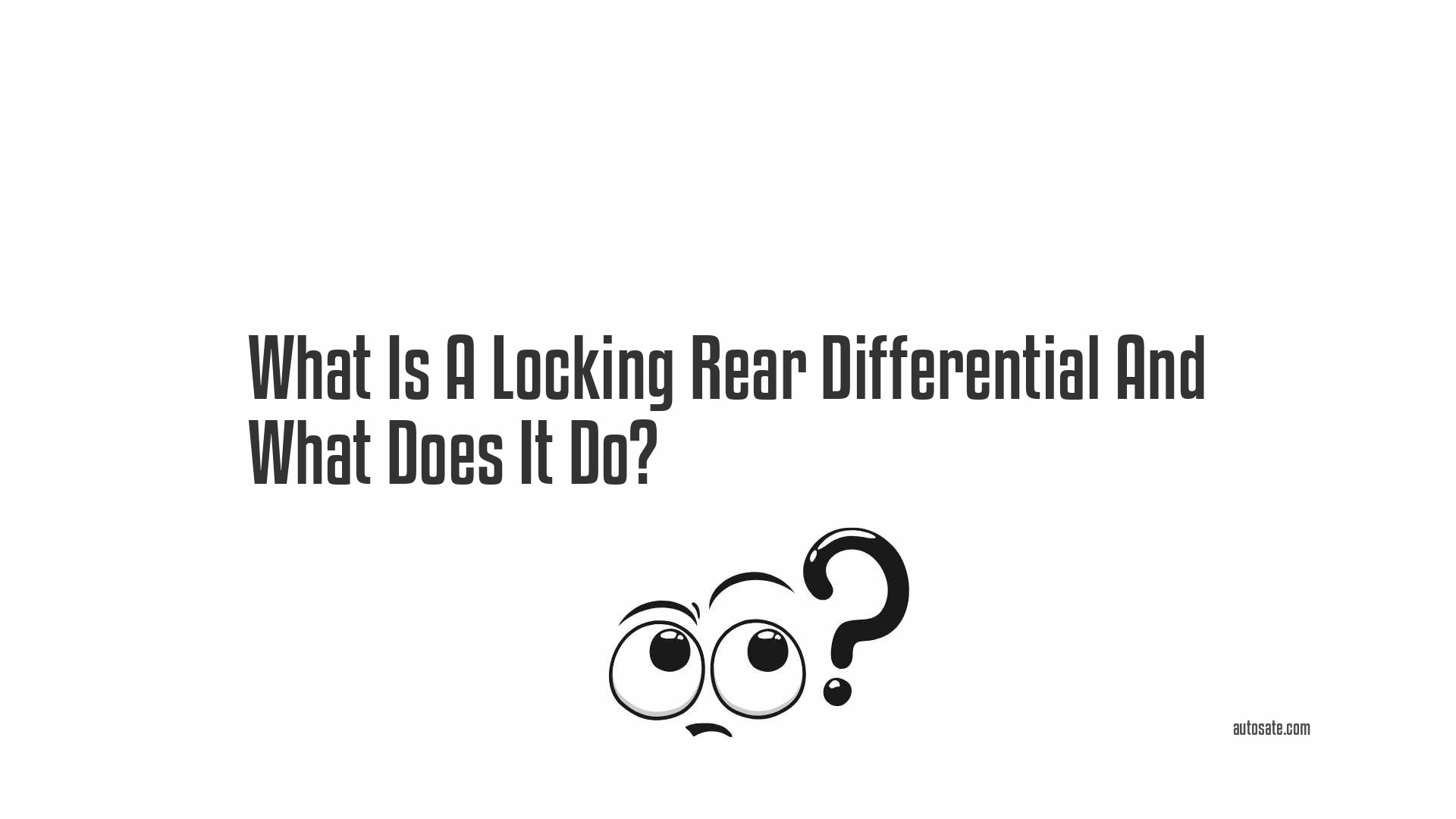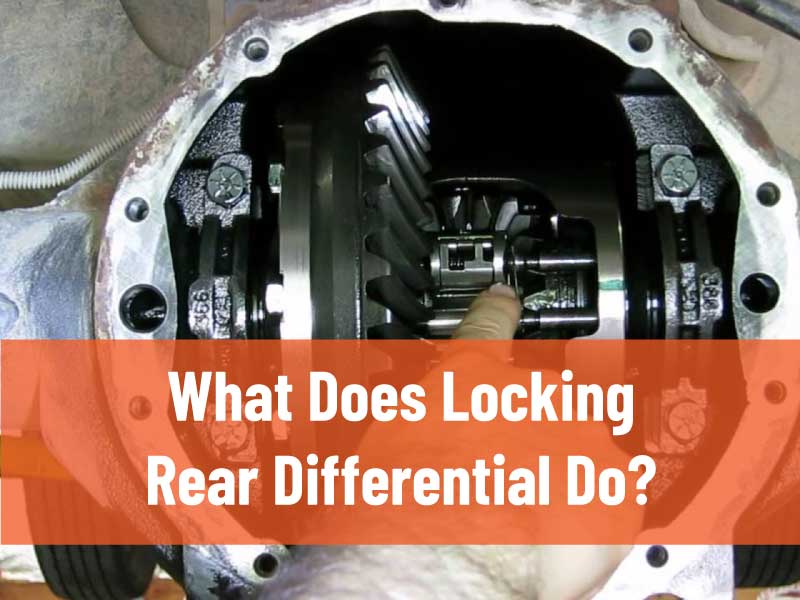The locking rear differential prevents the wheels from spinning at different speeds.
Locking the rear differential helps ensure that both wheels receive an equal amount of power when driving on difficult terrain. This can be especially helpful when driving on sand, snow, or mud.
What Is A Locking Rear Differential And What Does It Do?
A locking rear differential is a type of differential that locks the two rear wheels together so that they turn at the same speed. This is useful for off-road driving or when traction is poor.

A locking rear differential is a device that allows both rear wheels to rotate at the same speed, even if one is on a slippery surface. This can be extremely useful when driving in off-road or inclement weather conditions.
One of the benefits of a locking rear differential is that it can help prevent you from getting stuck. If one of your wheels starts to slip, the other wheel will still have traction, meaning you’ll be less likely to get stuck in the mud or snow.
Another benefit is that it can help improve your traction. This is especially useful if you’re driving in an off-road situation where you need all the traction you can get.
If you’re interested in getting a locking rear differential for your vehicle, there are a few things you need to know. First, you need to make sure that your vehicle is compatible with a locking rear differential. Not all vehicles are.
If you’re not sure, you can always check with your vehicle’s manufacturer or a mechanic.
Once you know that your vehicle is compatible, you’ll need to decide which type of locking rear differential you want. There are two main types: automatic and manual.
Automatic locking rear differentials are the most common type. They’re easy to use and don’t require any input from the driver.
Manual locking rear differentials are less common but can be more advantageous in some situations. They give the driver more control over when the differential is locked, which can be useful in off-road situations.
If you’re still not sure which type of locking rear differential is right for you, it’s a good idea to talk to a mechanic or another expert. They’ll be able to help you make the best decision for your vehicle and driving needs.
How Does A Locking Rear Differential Work?
A locking rear differential prevents one wheel from spinning faster or slower than the other wheel, providing extra traction.
If you’ve ever wondered how a locking rear differential works, or what it does, read on. This type of differential is designed to improve traction by “locking” the two rear wheels together so they turn at the same speed. This can be extremely helpful when driving on loose surfaces, such as sand, mud, or snow.
Here’s a step-by-step explanation of how a locking rear differential works:
- The locking rear differential is engaged when the driver turns a switch or presses a button.
- This action activates a series of gears and clutches inside the differential.
- The gears and clutches cause the two rear wheels to turn at the same speed, regardless of whether one is slipping.
- This helps improve traction and can prevent the vehicle from becoming stuck.
A locking rear differential can be extremely helpful when driving on loose or slippery surfaces. However, it’s important to note that this type of differential can also cause problems on dry pavement. When the rear wheels are locked together, they can’t rotate at different speeds. This can cause the tires to “scrub,” which can lead to premature tire wear.
If you’re driving on dry pavement and you begin to feel the tires “scrubbing,” it’s important to disengage the locking rear differential. This can be done by simply turning the switch or pressing the button. Once the differential is disengaged, the rear wheels will be able to rotate at different speeds, which will help prevent tire scrubbing.
What Are The Benefits Of A Locking Rear Differential?
A locking rear differential helps to distribute power evenly to both rear wheels, which can help prevent one wheel from spinning.
Locking rear differentials are a great way to increase traction, especially when off-roading. There are a few different ways to lock a rear differential, but the most common is with a locker. A locker is a device that is installed into the differential that essentially locks the two axles together, so they turn at the same speed. This is different than an open differential, which allows the axles to turn at different speeds (which is why your car doesn’t spin out when you make a turn).
There are a few benefits to having a locked rear differential. First, it increases traction. If you’re in a situation where one wheel is slipping, the locker will cause both wheels to slip, which helps you maintain traction and move forward. Second, it can help you get unstuck. If you’re stuck in the mud or snow, a locker will help you get moving again by providing extra traction.
Of course, there are a few downsides to having a locker. First, it can wear out your tires and brakes more quickly. Second, it can make your car harder to handle on the road, so you need to be extra careful when driving in wet or icy conditions.
Overall, a locking rear differential can be a great asset, especially if you do a lot of off-roading. Just be sure to weigh the pros and cons before you decide to install one in your car.
How Can A Locking Rear Differential Improve Traction?
A locking rear differential prevents one wheel from spinning faster or slower than the other, which can help improve traction.
If you have ever gotten stuck in the mud, you know how frustrating it can be. Your wheels can spin and spin, but you just can’t seem to get any traction. This is where a locking rear differential can come in handy.
A locking rear differential is a great way to improve traction, especially if you are frequently off-roading. This type of differential locks the two rear wheels together, so they always turn at the same speed. This can be extremely helpful when you are trying to get out of a sticky situation.
One thing to keep in mind is that a locking rear differential should not be used all the time. It should only be used when you are in a low-traction situation, such as when you are off-roading or in the mud. Overusing a locking rear differential can actually lead to decreased traction and increased wear and tear on your vehicle.
If you are frequently off-roading or find yourself in low-traction situations often, a locking rear differential is a great way to improve your traction and get you out of a bind. Just be sure to use it sparingly to avoid any potential damage to your vehicle.
What Are Some Of The Drawbacks Of A Locking Rear Differential?
A locking rear differential prevents the wheels from turning at different speeds, which can be a disadvantage on dry pavement or when making a turn.
Locking rear differentials are great for off-roaders because they allow both back wheels to get power at the same time. This helps with traction in slippery or uneven terrain. However, there are some drawbacks.
For one, a locked rear differential can cause your car to handle differently on the road. You may notice more tire squeals when making turns, and your car may feel less stable overall. Additionally, a locked rear differential can put extra strain on your drivetrain components, which can lead to premature wear and tear.
If you do a lot of off-roading, then a locking rear differential is a great addition to your vehicle. However, if you don’t do much off-roading, you might be better off without one.
How Does A Locking Rear Differential Impact Fuel Economy?
A locking rear differential is a device that helps to distribute power evenly to the wheels of a vehicle. It is usually used in four-wheel drive vehicles and can be found in the back of the vehicle. When the rear differential is locked, it can impact fuel economy because it causes the engine to work harder to turn the wheels. This can lead to the vehicle using more fuel than it would if the rear differential was not locked
Where Can I Get More Information On Locking Rear Differentials?
There are a few different ways to lock a rear differential. The most common way is to use a locker, which is a device that is installed in the differential that locks the two axles together. This prevents the differential from being able to spin independently of the axles and prevents the wheels from slipping. There are also limited slip differentials, which use clutch packs to allow some slip between the axles, but not enough to cause the wheels to slip. For more information on locking rear differentials, you can consult a mechanic or an automotive specialist.
What Are Some Of The Common Problems That Can Occur With A Locking Rear Differential?
If the locking mechanism on the rear differential fails, it can cause the differential to lock up while driving. This can lead to loss of control of the vehicle and can be very dangerous. Additionally, if the locking mechanism is not properly maintained, it can cause the differential to wear out prematurely.
What Are Some Of The Maintenance Requirements For A Locking Rear Differential?
Locking rear differentials require regular maintenance to keep them functioning properly. This includes checking the fluid level and condition, as well as the condition of the locking mechanism itself. The differential should be checked and serviced according to the manufacturer’s recommendations.
How Does A Locking Rear Differential Affect Vehicle Handling?
The main purpose of a locking rear differential is to prevent one wheel from spinning faster or slower than the other wheel when traction is lost. This can happen when one wheel is on a slippery surface, such as ice, and the other wheel is on a dry surface. A locking rear differential prevents the wheel with the least traction from spinning and allows both wheels to provide power to the vehicle. This can improve vehicle handling because both wheels are providing power to the vehicle, instead of just one wheel
If you’re still unsure about what locking a rear differential does, please leave a comment below and we’ll try to help clear things up.


